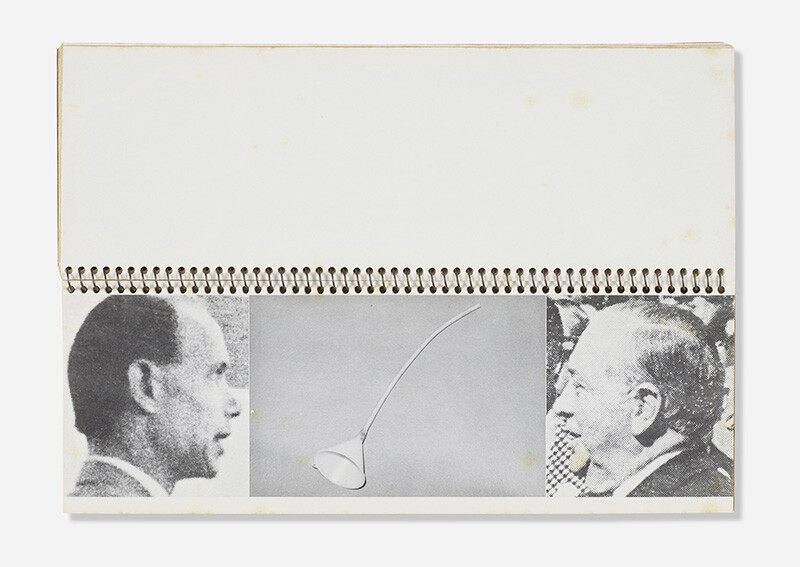234
234
1971-76
bound printed paper, printed paper
bound printed paper, printed paper
estimate: $1,500–2,000
result: $1,625
follow artist
This work will ship from Rago in Lambertville, New Jersey.
Side by Side: Gilbert & George the Sculptors 1971 Gilbert & George, Konig Brothers, Cologne / New York, 1972. Signed and numbered. This work is number 586 from the edition of 600.
Dark Shadow: George & Gilbert the Sculptors 1974 GIlbert & George, Nigel Greenwood, London, 1976. Signed and numbered. This work is number 853 from the edition of 2000.
Gilbert & George Publication Checklist and Exhibition Postcard. Postcard is for a 1978 exhibition at Sonnabend Gallery.
George and Gilbert The Living Sculptors London: Catalogue for the 1973 Australian Visit Gilbert & George, Art for All, London, 1973.
The Paintings (With Us in the Nature) of Gilbert & George the Human Sculptors Gilbert & George, Koninklijk Museum voor Schone Kunsten, Antwerpen, 1972.
A Guide to Singing Sculpture and A Day in the Life of George & Gilbert the Human Sculptors Gilbert & George, Art for All, London, 1973 / 1971. Two small booklets in one envelope stamped 'Carrying On Sculpting G/G'. Stamped GG in red at the end of each booklet.
Oh, The Grand Old Duke of York Gilbert & George, the Sculptors, Kuntsmuseum Luzern, Lurzern, 1972.
Artists who publish books of documentation are, in a sense, using the artform to its simplest degree. —Tim Guest, 1981
Sharing an artwork through the very public method of printing and reproduction is the epitome of democratic dissemination. In their seminal 1981 publication Books By Artists, Tim Guest and Germano Celant begin by addressing their audience’s predictable desire to define a book. They suggest that it is not really possible – or necessary – to define what an artist book is, because any given work becomes a conceptual extension of the artist and is therefore an object of infinite incarnations.
There is too frequently a misinterpretation of printed works and editions as lesser commodities in the market. With artist’s books, the goal was often to distance an artist’s idea from the proverbial canvas, to use words and non-dimensional media as a means to engender and distribute a creative philosophy. Such efforts often led to the creation of superbly idiosyncratic editioned works that succinctly communicate an artist’s entire conceptual foundation, however ineffable. In this way, the artist’s book and the development of conceptual art are inextricably linked. Take, for example, Seth Siegelaub’s July, August, September 1969 exhibition catalogue in which the book is the exhibition. On its pages, it brings together eleven works from eleven artists working in separate locations, works that never physically shared premises themselves.

For artists like John Baldessari and Ed Ruscha, whose broad outputs often hinged on the collision of word and image, the book became a quintessential medium. One of my favorites from this selection is Baldessari’s rare Brutus Killed Caesar, in which two unknown antagonists face each other with a randomized household object between them. It is understood that these objects are murder weapons, but nothing violent takes place outside of the viewer’s imagination, likely shaped by earlier historical texts like Shakespeare’s The Tragedy of Julius Caesar. Brilliant. Another scarce title herewith is Ruscha’s Dutch Details. Comprised of multiple images taken by the artist showing bridges in The Netherlands, it plays off of his Every Building on the Sunset Strip from five years earlier. Oblong as well, with large fold-outs, this book was very difficult to produce and the publisher did not fulfill the edition, therefore making this the rarest of Ruscha’s coveted artist books.
The book’s potential for comprehensively documenting an ephemeral work or performance was critical for many artists, including Gordon Matta-Clark and Bruce Nauman, the latter whom made an artist’s book (Burning Small Fires) about burning another artist’s book (Ruscha’s Various Small Fires and Milk).
The pursuit to collect such a wide and comprehensive library of these titles is a passionate endeavor, and it is my view that no collection could be complete without the artist’s book. A personal library needs this texture to augment the rigid monographs and academic surveys that equate the bulk of most collections. Whether a single rarity catches your eye or you’re drawn to group lots from the likes of Christian Boltanski, Gilbert & George, Richard Prince, and Sol LeWitt, Cover to Cover is a fantastic opportunity to bolster an existing reading room or to plant the seed of a collection to cherish for years to come.
—Peter Jefferson, Senior Specialist
Auction Results Gilbert & George